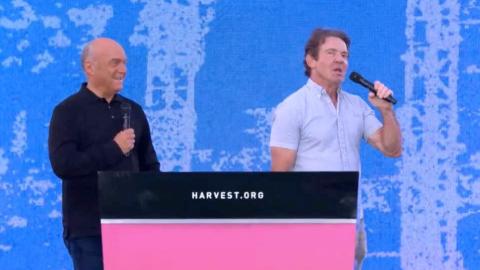
Meeting Jesus in Real Time: Why the 'He Gets Us' Ads Are Just a First Step
ANALYSIS - After the recent Super Bowl ad by the He Gets Us campaign, a number of Christians have raised questions about whether He Gets Us presents a truthful picture of Jesus. Based on various online posts and comments following the commercial, it would seem that Christians are concerned with the public presentation and the “simplification” of Jesus. Jesus carries a theological significance for Christians that moves beyond that of any other historical figure. Jesus is the Son of God, Savior, and Lord. At the same time, Jesus, who has always been, entered into history and walked among us as “one who in every respect has been tempted as we are, yet without sin” (Heb 4:15). Like any historical figure, we should take care to present Jesus in a manner that aligns with the Bible. Yet, we should not forget that there were many who experienced Jesus for the first time in real time.
Christians have the luxury of seeing the bigger picture about Jesus. Looking back at Jesus’ life after the resurrection and ascension and through the inspired lens of the scriptures, Christians have been given a framework to understand who Jesus is, what Jesus has done, and how who he is and what he has done fundamentally changes the way we understand God, ourselves, others, and the world. We look back on Jesus’ various acts of kindness, generosity, and love through the lens of his crucifixion, resurrection, and ascension. Because we believe Christ and his way of life were vindicated in the resurrection, we understand that Christ’s way of life wasn’t simply “a good way to live” but the only way to live now and into eternity.
It can be difficult for us as modern-day Christians to remember that there are those who have no concept of who Christ is. Believing in Christ on this side of the resurrection can make it easy to forget that those in Jesus’ day would have had to watch Jesus in real-time. Their understanding of the significance of Jesus grew over time with new information coming as they walked along with Jesus. For instance, in John 6, Jesus feeds the five thousand and then departs across the sea to Capernaum (Jn 6:1-21). The crowds follow him to the other side of the sea, where Jesus explains that the bread they should be seeking is not of the sort they could eat, but rather his own body (Jn 6:22-65). Having heard this teaching, “many of his disciples turned back and no longer walked with him” (Jn 6:66).
Those who initially appreciated Jesus for what he did or said ultimately parted ways with him because they came to know him more fully. In real time, Jesus was compelling for a number of reasons all of which were related to who Jesus was. However, those who interacted with Jesus in real time didn’t fully comprehend the connection between what Jesus said and did and who he really was. As individuals understood who Jesus was more fully, they were faced with a transformative decision. They had to decide whether the life they were giving up was of less value than the life they would be adopting in choosing to follow Christ. That transformative decision wasn’t always made at one’s first encounter with Jesus. Experiencing Jesus in real time often delayed that decision to the point at which those interacting with him discovered that Jesus was not simply a guy who provided the hungry with bread, healed the sick, loved his enemies, or confronted a corrupt status quo. They came to realize that Jesus was not someone with whom they could permanently align without undergoing the sort of radical changes discipleship requires.
The Christian community needs to recognize that while we live in a post-resurrection world and have a sacred, inspired text that affords us a fuller understanding of Christ, people still meet Jesus in real time. They don’t see the full picture… only a piece. Just as Jesus didn’t lead with “eat my flesh and drink my blood,” we may need to introduce others to Christ in truthful ways that aren’t full of “hard sayings” knowing that as they come to know Jesus, they will not be able to avoid those “hard sayings” forever. He wasn’t hiding who he was or attempting a “bait and switch.” He was showcasing his identity in other ways and clarifying and expanding on his identity as people became more familiar with him.
Clearly, we should take care in how we present Jesus. We want people to have a life-changing encounter with Jesus where they wrestle with the transformative decision of whether to follow Christ or reject him. We don’t want to make assertions about Christ that are untrue. We want to avoid the dangers of abbreviation. As Aldous Huxley suggests, we must “learn to simplify, but not to the point of falsification.” He Gets Us is an abbreviation. It doesn’t tell the whole story of Jesus, nor would I presume they would claim to be doing so. They are introducing people to Jesus, which would seem to require some abbreviation.
Whatever else may be said about He Gets Us, we should remember that many people today are experiencing Jesus in real time. Those experiences will always be incomplete at the beginning and grow in breadth and depth as individuals read the scriptures, speak with God’s people, and consider the church’s testimony as the body of Christ seeks to demonstrate the “manifold wisdom of God” (Eph 3:10).
Dr. James Spencer currently serves as President of the D. L. Moody Center, an independent non-profit organization inspired by the life and ministry of Dwight Moody and dedicated to proclaiming the Gospel and challenging God’s children to follow Jesus. He also hosts a weekly radio program and podcast titled “Useful to God” on KLTT in Colorado. His book titled “Christian Resistance: Learning to Defy the World and Follow Jesus” is available on amazon.com. He previously published “Useful to God: Eight Lessons from the Life of D. L. Moody,” “Thinking Christian: Essays on Testimony, Accountability, and the Christian Mind,” as well as co-authoring “Trajectories: A Gospel-Centered Introduction to Old Testament Theology.”



